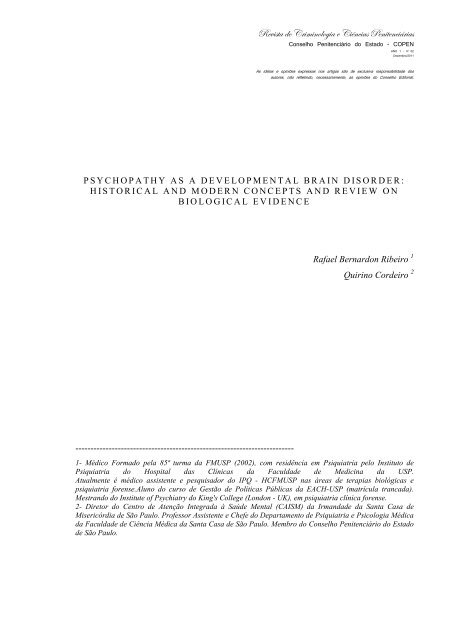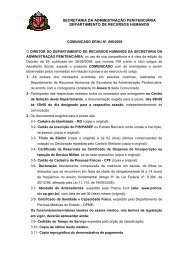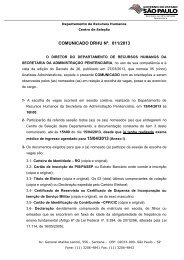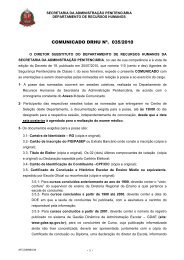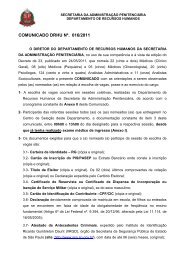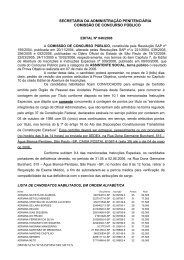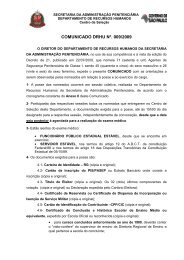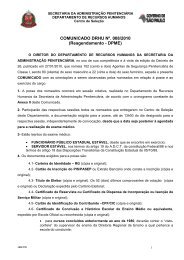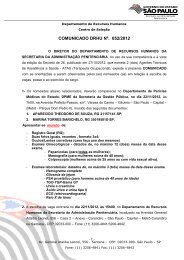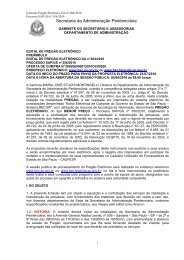exä|áà t wx VÃ|à |ÃÃÃÃz|t x V|£Ãv|tá cxÃ|à xÃv|öÃ|tá - Procrim
exä|áà t wx VÃ|à |ÃÃÃÃz|t x V|£Ãv|tá cxÃ|à xÃv|öÃ|tá - Procrim
exä|áà t wx VÃ|à |ÃÃÃÃz|t x V|£Ãv|tá cxÃ|à xÃv|öÃ|tá - Procrim
You also want an ePaper? Increase the reach of your titles
YUMPU automatically turns print PDFs into web optimized ePapers that Google loves.
exä|áàt <strong>wx</strong> VÜ|Å|ÇÉÄÉz|t x V|£Çv|tá cxÇ|àxÇv|öÜ|táConselho Penitenciário do Estado - COPENANO 1 – nº 02Dezembro/2011As idéias e opiniões expressas nos artigos são de exclusiva responsabilidade dosautores, não refletindo, necessariamente, as opiniões do Conselho Editorial.ResumoA psicopatia é uma condição que tem intrigado a humanidade há séculos. Seria uma simplesquestão de falta de moralidade, desvio de caráter e de maldade? Muitos autores importantesdiscorreram a respeito, como Pritchard, Schneider, Cleckley e Hare, desde o século XIX. Oconceito evoluiu, as ferramentas diagnósticas, e os mecanismos biológicos subjacentes. Aciência passa a entender estas pessoas como portadoras de múltiplas disfunções cerebrais,marcadamente no sistema límbico, que justificam seus comportamentos desviados.Destacamos a hipofunção da amígdala, que é responsável pela detecção de medo e tristeza,pelo condicionamento frente a estímulos aversivos, expressão do medo, e leitura ou previsãodo comportamento alheio. Estruturas conectadas à amígdala, como o córtex prefrontalmedial, cíngulo anterior e lobo temporal não são menos importantes na gênese da condição.Neste artigo, exploramos os aspectos biológicos (neuroimagem funcional e estrutural,genética e função neuronal intrínseca) por trás desta grave condição, que se inicia nainfância e segue por toda a vida, causando imensos prejuízos à sociedade.
exä|áàt <strong>wx</strong> VÜ|Å|ÇÉÄÉz|t x V|£Çv|tá cxÇ|àxÇv|öÜ|táConselho Penitenciário do Estado - COPENANO 1 – nº 02Dezembro/2011As idéias e opiniões expressas nos artigos são de exclusiva responsabilidade dosautores, não refletindo, necessariamente, as opiniões do Conselho Editorial.of other individuals” 3 . In other words, its related to our capability and intrinsic biologicalstructures that allows us to understand other people's emotions (based on visual facial andposture pattern recognition) and, in a further and more complex phenomenon, to predict theactions that will take place, based on this emotion recognition. This function is fundamentalfor social cognition that leads to good social skills and prosocial actions. Seems to beimpaired in psychopaths and autistic patients. The amygdala and the limbic system as a wholeplay a fundamental role in mental states attribution (recognition of expressive gestures andintentional behaviour). Specifically regarding emotional processing, its connection withsubgenual anterior cingulate cortex appears to be important to control and suppress, viafeedback, the amygdala 14 . It is also suggested to be responsible for processing the emotionalcontent, via aferences from the mirror neuron system, and involved in imitation andrecognition of emotions. 3Antonio Damasio defines the amygdala as one of the most important structures within thelimbic system. Bilateral damage can lead to lifelong emotional impairment, leading to socialinadequacy, affective indifference and fear expression or perception impairment 4,5 . Since, forhim, all the reasoning and cognition passes through emotion and the “body proper”projections (autonomic outputs from the brain, generating body reactions that will be “read”,in a loop, by the brain and will guide our decisions and instincts), this impairment willcompromise all our judgement system. So, bodily changes could define an emotion. To feelan emotion, we have to connect an object conscious representation (image) and the emotionalbody state. The primary (innate) emotions, like fear, anger, sadness, happiness and disgust,depend on limbic structures, particularly on the amygdala and the anterior cingulate gyrus 4 .Since primary emotions are the basis for secondary (more complex, acquired and elaborated)
exä|áàt <strong>wx</strong> VÜ|Å|ÇÉÄÉz|t x V|£Çv|tá cxÇ|àxÇv|öÜ|táConselho Penitenciário do Estado - COPENANO 1 – nº 02Dezembro/2011As idéias e opiniões expressas nos artigos são de exclusiva responsabilidade dosautores, não refletindo, necessariamente, as opiniões do Conselho Editorial.emotions, without the first, we can't have the second. 4 Damage to the amygdala also makesthe patient incapable of recognizing fear in others – and even mentalizing the fear expression.They can not classify faces as trustworthy of not; in other words, they can not make propersocial judgements and suffer of excessive trusting behaviour 5 .(image source: http://www.lindenmethodinfo.com/wpcontent/uploads/2010/06/amygdala.jpg)The psychopathyWe can trace back some nosological descriptions of what today we call psychopathy to theXIX century, when James Cowles Prichard (1786-1848), introduced his definition of “moralinsanity” in an article published in 1833 in “The cyclopaedia of practical medicine”. Hestated: “... a form of madness consisting in a morbid perversion of the natural feelings,
exä|áàt <strong>wx</strong> VÜ|Å|ÇÉÄÉz|t x V|£Çv|tá cxÇ|àxÇv|öÜ|táConselho Penitenciário do Estado - COPENANO 1 – nº 02Dezembro/2011As idéias e opiniões expressas nos artigos são de exclusiva responsabilidade dosautores, não refletindo, necessariamente, as opiniões do Conselho Editorial.WHO'S LOONEY NOW? “ 8This overture is quite symbolic and amazing. Dr. Cleckley calls our attention for the difficultytask of defining sanity and, furthermore, the wide range of nuances that separates lunaticsfrom rational and sane men, in a continuum, rather than a manichean “good and evil”definition. His concerns are towards those who look like sane and competent, but represent “ahigher risk to society than those called insane or mentally ill”. The name of the book is basedon the sanity mask that those individuals show to us, even having an underneath seriousbehavioural problem, being incapable of having a normal social life. They were not“psychotic or psychoneurotic” - “a challenging enigma” for medical science. He based hiswork on his clinical experience in asylums and its interface with the justice system. Henoticed a set of patients that could not learn from their previous experience, had shallowaffect, were parasitic oriented, use of instrumental aggression and were a burden to society.They had in common a deviated pattern of behaviour, tending to disregard moral conventionsand laws, tending to exhibit a high degree of maladjustment. He describes 15 cases of his ownpractice, as examples of the disorder. His sample was biased – he didn't assist deeply perverseand cruel inmates like serial killers or murderers, which were more likely to be in prison, orhigh functioning corporative psychopaths. Generally his descriptions are of anecdotal andtypical patients, who committed copiously minor offences, an where sent back to hospitalgrounds numerous times, being release always under the promise to behave themselves 8 .
exä|áàt <strong>wx</strong> VÜ|Å|ÇÉÄÉz|t x V|£Çv|tá cxÇ|àxÇv|öÜ|táConselho Penitenciário do Estado - COPENANO 1 – nº 02Dezembro/2011As idéias e opiniões expressas nos artigos são de exclusiva responsabilidade dosautores, não refletindo, necessariamente, as opiniões do Conselho Editorial.short term marital relationships, juvenile delinquency, revocation of conditional release,criminal versatility. They can be divided in two factors (affective/interpersonal andantisocial/criminal lifestyle) and four facets (interpersonal, affective, lifestyle and antisocial).The cut-off varies a little among the different countries and cultures: in Brazil, it's 23; in theUK, 25; and in the USA and Canada, 30 points 11 .Neurodevelopmental aspects of psychopathyThe developmental aspects of psychopathy have drawn attention to the study of children andadolescents with behavioural problems, particularly related to Attention Deficit andHyperactivity Disorder (ADHD) and antisocial behaviours (conduct disorders – CD) 12, 16 . Thesubset of patients presenting callous and unemotional (CU) traits in childhood is known tohave enhanced likelihood of developing adult psychopathy. The hallmark for the CU subtypeis the lack of guilt or empathy 16 . The antisocial personality disorder, psychopathy andconduct disorder are not the same, but there is a clear relationship among them;syndromically speaking there is an overlaping of symptoms, maybe constituting a continuum(from low grade ASPD towards high grade psychopathy) or an evolutionary phase (forconduct disorder in relation to ASPD or Psychopathy). Fact is, most of the psychopaths canbe also classified as having antisocial personality disorder (ASPD), being the reversal untrue(only one third of ASPD are psychopaths) 12, 21 . There is a landmark separating the CDchildren in two different groups, with a very distinct clinical evolution: the callousunemotional(CU) and the non-callous-unemotional (non-CU) 16 . The manuals, so far, focuse
exä|áàt <strong>wx</strong> VÜ|Å|ÇÉÄÉz|t x V|£Çv|tá cxÇ|àxÇv|öÜ|táConselho Penitenciário do Estado - COPENANO 1 – nº 02Dezembro/2011As idéias e opiniões expressas nos artigos são de exclusiva responsabilidade dosautores, não refletindo, necessariamente, as opiniões do Conselho Editorial.their polythetic diagnostic criteria in antisocial acts, like aggression, assaults, arson, stealing,lying, criminal justice involvement, problems in maintaining relationships, violence etc. So,it's more focused in expressed behaviour rather than in its underlying causes, inner personaldispositions and affective/emotional fundamental impairments. The manuals (ICD-10 orDSM-IV) still don't separate what appears to be diametrically opposed sub-types: the CU-CDand non-CU-CD, being the same true for ASPD with or without psychopathy. Distinguishingthese two groups is important in terms of treatment planning and prognosis evaluation, sincethe CU patients respond less to interventions and have a worse prognosis 17,18 . They startoffending younger, their offences are more violent and they are more likely to be antisociallifelong, reflecting their lack of empathy 16 . These children, comparing with other childrenwith externalising disorders (like CD or autism), are less distressed by their own behaviour,they are ego-syntonic, and these features facilitate the persistence of antisocial acts(demonstrating problem in moral judgement, which evolves structures as dorsolateralprefrontal cortex and anterior cingulate, this last depending on emotional signalling from theamygdala). In other words, these cited structures, to perform reasoning, decision-making andconflict processing, depend on emotional signalling (and, maybe, bodily emotionalprojections), to perform their tasks 4 . CU people, having impaired amygdalar function, willfail in moral judgement and will not get distressed by their inadaptative behaviour 5, 16, 17 .The aetiology is not known, but there is a strong suggestion of high genetical influence, beingthe environment almost negligible in the natural history of CU patients 12, 18 . In one study, aheritability of 67% was found, meaning that the important differences in CU traits found inthese children, compared to normal probands, is explained by genetics in one third of thecases 16. . Giving a reference to compare, the heritability for CD + non-CU is 30% 16 .
exä|áàt <strong>wx</strong> VÜ|Å|ÇÉÄÉz|t x V|£Çv|tá cxÇ|àxÇv|öÜ|táConselho Penitenciário do Estado - COPENANO 1 – nº 02Dezembro/2011As idéias e opiniões expressas nos artigos são de exclusiva responsabilidade dosautores, não refletindo, necessariamente, as opiniões do Conselho Editorial.Blair suggests that classical conditioning (Pavlovian) and instrumental learning are necessaryfor proper socialisation and acquisition of the necessary skills. So, the humans need to learnfrom experience, reinforcements and punishments. This population has a great difficulty tolearn from past errors and punishment, to process fearful stimuli and to recognize sadness inothers 14,18 . As stated before, one of the functions of the amygdala is to process emotions,markedly fear, and to “read” other peoples' emotions and intentions (Theory of Mind). Thisclinical finding also corroborates with Damasio's theories about feelings and emotionsprocessing. Psychopaths can not have proper somatic representations of emotions, since theyhave amygdala and prefrontal cortex dysfunction, being unable to feel and to recognizefeelings. Their body-mind loop is “broken”. 4This impairment seems to be one of thecornerstones of psychopathy neuropathology. And there is evidence of progressive(developmental) evolution, since only adults with callous-unemotional traits (psychopathy)present orbitofrontal cortex dysfunction, as compared with children 12 . More disturbing is thefact that the emotionally impaired group seem not to respond to adequate and emphaticparenting or good environmental background, leading to a very poor prognosis. 12In a 2008 review, Blair also cites the ventromedial prefrontal cortex (which includes anteriorand rostral regions of the cingulate gyrus) as an important structure in psychopathyneuropathology 14 . The amygdalar basolateral nuclei are related to operative conditioning(conditioned–unconditioned stimulus associations). These associations are important forcontrolling its central nucleus, which has projections towards hypothalamic and brainstemstructures, controlling behavioural, autonomic and neuroendocrine responses; besides, it isalso connected to the ventromedial prefrontal cortex, in a network that commands thedecision-making processes 14 . The system is not involved only in aversive conditioning, but
exä|áàt <strong>wx</strong> VÜ|Å|ÇÉÄÉz|t x V|£Çv|tá cxÇ|àxÇv|öÜ|táConselho Penitenciário do Estado - COPENANO 1 – nº 02Dezembro/2011As idéias e opiniões expressas nos artigos são de exclusiva responsabilidade dosautores, não refletindo, necessariamente, as opiniões do Conselho Editorial.also in positive (appetitive) conditioning. The subgenual anterior cingulate cortex, part ofventromedial prefrontal cortex, receives the emotional inputs from amygdala and thesupragenual cingulate cortex controls its activity, suppressing the emotional arousal 14 .Indeed, there is inferential data since the 70's that shows that psychopaths are much lessresponsive to punishment than to rewarding in cognitive-behavioural attempts of therapy 15 . Ina particular observational study with token economy in a prison, when punishment started tobe widely used, the drop-out rates grew exponentialy 15 . When the positive reinforcementmodel was reintroduced, the program started to work again. This corroborates newer studieswhich have shown that, in psychological treatments for psychopathy, punishment does notwork. These findings suggest a link with amygdalar malfunctioning and psychopathy, andmaybe there is a qualitative difference between the appetitive and aversive systems, being thefirst slightly more useful for treatment purposes.More recent studies, focusing boys with callous–unemotional conduct problems as comparedwith normal controls have shown increased grey matter concentration in the medialorbitofrontal cortex and the anterior cingulate cortex (both rostrally and dorsally), againpointing to the limbic system 13 . These regions are known to have projections coming andgoing to the amygdala, and are associated to decision-making, morality, and empathy 1, 12, 13 .In this specific study, no differences in amygdala volume were detected 13 . These structuraldifferences suggest that the orbitofrontal cortex might be associated with poor moralreasoning. However, the specific causes remain unclear. It's suggested that the noradrenergicsystem could lead to the amygdala dysfunction, since β-blockers (as propranolol) can blockthe improvement in traumatic memory arousal and can impair the processing of sad facialexpressions 12 . Other important neurotransmitters that are involved in regulating aggression
exä|áàt <strong>wx</strong> VÜ|Å|ÇÉÄÉz|t x V|£Çv|tá cxÇ|àxÇv|öÜ|táConselho Penitenciário do Estado - COPENANO 1 – nº 02Dezembro/2011As idéias e opiniões expressas nos artigos são de exclusiva responsabilidade dosautores, não refletindo, necessariamente, as opiniões do Conselho Editorial.and emotional response are serotonin and dopamine. The first modulates behaviouralinhibition and the reward system 22 .Genes controlling the activity of the serotonintransporter (5HTT) and the enzymes monoamine oxidase (MAOA) and catechol-Omethyltransferase(COMT) have been associated to psychopathy. Individuals with lowMAOA and 5HTTT were significantly more dysfunctional emotionally and had higherpsychopathy scores 23 . High COMT activity was associated just to high emotional dysfunction23 . These findings suggest that these alterations in serotonergic and dopaminergicneurotransmitter may cause the functional impairment at the amygdala and the PFC 23 .Neuroimaging studies have shown that the degree of psychopathy can be inversely relatedwith the amygdalar volume (f MRI). 12 Raine reported that individual scoring highly on thePCL–R had reduced prefrontal grey, but not white, matter, pointing to another anatomicalmarker 12 . In a review, strong evidence from neuroimaging was found implicating amygdalarhypofunction (reduced reactivity) and psychopathy (poor emotional processing) 18 . There wasalso a left amygdala volumetric reduction in one report 18 . Testing reactions to fearful faces inboys with conduct problems (CU+ and CU-), using f MRI, was found just left amygdalaractivation, suggesting that CU traits might be linked to low right amygdalar function. Besidesthis, comparing to normal individuals, the amygdalar function was reduced bilaterally 18 . Allthese findings in children and adolescents reported above suggest that the hypothesis ofpsychopathy being a developmental disorder is right 18 .One last study came to our attention, pointing psychopathy as a “disease of the moralbrain” 21 . Was suggested that most studies have focused in just a few large structures(temporal cortex and PFC), based on brain injury (“acquired sociopathy”) models. Thesepsychopathic-like patients don't have all the features of the syndrome and there is evidence
exä|áàt <strong>wx</strong> VÜ|Å|ÇÉÄÉz|t x V|£Çv|tá cxÇ|àxÇv|öÜ|táConselho Penitenciário do Estado - COPENANO 1 – nº 02Dezembro/2011As idéias e opiniões expressas nos artigos são de exclusiva responsabilidade dosautores, não refletindo, necessariamente, as opiniões do Conselho Editorial.that psychopathy is caused by a large number of interconnected and interdependent structures,distributed all over the brain 21 . Based on previous studies, were selected the following areasof interest: basal forebrain-hypothalamus, frontal and temporal poles, superior temporalsulcus region and orbitofrontal cortex. Using voxel-based structural MRI, the study comparedASPD patients (positive for psychopathy using the PCL Search Version) versus normalcontrols. In the patient's group there were significant volumetric reductions at the frontopolarcortex (left and right), the posterior medial orbitofrontal/ventral subgenual cortex, andsuperior temporal sulcus (bilaterally). 21 The degree of reductions, as seen in other studies,reflects the severity of psychopathy. Behavioural control and electrodermal response deficitshave been related to OFC; the FPC is implicated in long-term planning and reasoning(including in moral tasks); the temporal areas might be involved in semantic cognition and“social reading”/ Theory of Mind tasks; the insula can be associated to somatic/bodily statesprocessing and association with other brain areas; the VMPFC is related to empathy andprosocial acts. So, this is a very unspecific and wider picture, suggesting that the anatomicsubstract for psychopathy is diffuse and complex 21 .Conclusion and discussionIf we were to point one single structure implicated in psychopathy aetiology, it would be theamygdala. Is the widely studied (neuroimaging, BOLD, Megneto-Encephalography, f MRI,PET and neuropsychological tests), and almost always found to be dysfunctional in CU
exä|áàt <strong>wx</strong> VÜ|Å|ÇÉÄÉz|t x V|£Çv|tá cxÇ|àxÇv|öÜ|táConselho Penitenciário do Estado - COPENANO 1 – nº 02Dezembro/2011As idéias e opiniões expressas nos artigos são de exclusiva responsabilidade dosautores, não refletindo, necessariamente, as opiniões do Conselho Editorial.patients. So, the amygdala is one of the main brain structures related to psychopathy, as itencompasses fear perception and processing, stimulus-conditioning behaviours and intentionattribution (mentalization). So far, we can argue that psychopaths have all these functionsimpaired, pointing to the amygdala as the responsible. They show important failure inlearning from aversive or appetitive stimulus, (not forming stimulus–reinforcementassociations) they don't respond to emotional expressions, like fearful and sad ones, all ofthese processes being fundamental for socialization and adaptation. Not learning fromnegative experiences and that some attitudes are bad, they are much more prone to useantisocial and predatory strategies when interacting 14,18 . The psychopaths also have less or noautonomic reactions when prepared/instructed about a future fear situation. This normalreaction is mediated by amygdalar activation 14 . Another finding is the fact that these patientsare less influenced by emotional distracters in experimental models, another role played byamygdalar function. But, we can not ignore that the amygdala is part of a very complexsystem of interconnected limbic structures (prefrontal cortex, as the ventromedial region,cingulate gyrus, hippocampus, etc) 12,14,18 . All these structures have a core role in emotionprocessing, moral judgement, impulse control 17 . The ventromedial prefrontal cortex, inparticular, appears to be very important in regulating amygdalar activity (negative feedbackafter arousal, from anterior cingulate) 18 . Besides this, another paper from this author showsthat psychopaths have semantic and language impairments (they can not couple semantic andemotional representations), demonstrating that there are other domains, such as temporal andparietal lobes, might be involved in psychopathy pathology (or its connections with the limbicsystem and prefrontal cortex) 19 . Damasio's theories, implicating bodily emotional (somatic)reactions as important part of emotional processing, are also interesting and can be part of the
exä|áàt <strong>wx</strong> VÜ|Å|ÇÉÄÉz|t x V|£Çv|tá cxÇ|àxÇv|öÜ|táConselho Penitenciário do Estado - COPENANO 1 – nº 02Dezembro/2011As idéias e opiniões expressas nos artigos são de exclusiva responsabilidade dosautores, não refletindo, necessariamente, as opiniões do Conselho Editorial.puzzle 4 . Neuropsychological tests in patients with amygdala damage shows fear and sadnessprocessing impairment and deficits in conditioning learning, the same findings in CU patients18 . They also show reduced eye gaze to the interlocutor eye, observation seen as a partialexplanation for the impairment in emotion (fear or sadness) recognition, needing furtherinvestigation 14 .Concluding, the two core regions related to psychopathy so far are both the amygdala andthe ventromedial prefrontal cortex. It'll be difficult to dissociate them, since they worktogether and both appear to be hypofunctional in brain imaging studies 14,18,20 . It's aneurodevelopmental brain disfunction/disorder that is present since childhood (functionally,anatomically and in expressed behaviour), and that probably progresses as growth takes place16, 18, 21 . The investigation of biological markers (genetic and structural/functional brainimaging) is necessary to detect the underlying causes and will be a starting point to newprecocious treatment and preventive measures still in childhood.REFERENCES:1 Morrison SE, Salzman CD. Re-valuing the amygdala. Curr Opin Neurobiol. 2010Apr;20(2):221-30. Epub 2010 Mar 17
exä|áàt <strong>wx</strong> VÜ|Å|ÇÉÄÉz|t x V|£Çv|tá cxÇ|àxÇv|öÜ|táConselho Penitenciário do Estado - COPENANO 1 – nº 02Dezembro/2011As idéias e opiniões expressas nos artigos são de exclusiva responsabilidade dosautores, não refletindo, necessariamente, as opiniões do Conselho Editorial.2 Maren S. Pavlovian fear conditioning as a behavioral assay for hippocampus and amygdalafunction: cautions and caveats. Eur J Neurosci. 2008 Oct;28(8):1661-6.3 Mier D, Lis S, Neuthe K, Sauer C, Esslinger C, Gallhofer B, Kirsch P. The involvement ofemotion recognition in affective theory of mind. Psychophysiology. 2010 Nov;47(6):1028-394 Damasio A. Descartes' Error. Vintage Books, 2006.5 Damasio A. The feeling of what happens. Vintage Books, 2000.6 Augstein HF. J C Prichard's concept of moral insanity--a medical theory of the corruption ofhuman nature. Med Hist. 1996 Jul;40(3):311-43.7 Schneider K. Las Personalidades Psicopáticas. 2.a Edición. Ediciones Morata, Madrid, 1948.8 Cleckley H. The Mask of Sanity. Fifth Edition, 1988.9 Kaplan & Sadock. Synopsis of Psychiatry. 10 th Edition, Lippincott Williams & Wilkins,2007.10 Hare RD. Psychopathy: a clinical and forensic overview. Psychiatr Clin North Am. 2006Sep;29(3):709-24. Review.
exä|áàt <strong>wx</strong> VÜ|Å|ÇÉÄÉz|t x V|£Çv|tá cxÇ|àxÇv|öÜ|táConselho Penitenciário do Estado - COPENANO 1 – nº 02Dezembro/2011As idéias e opiniões expressas nos artigos são de exclusiva responsabilidade dosautores, não refletindo, necessariamente, as opiniões do Conselho Editorial.11 Hare RD. Hare Psychopathy Checklist-Revised (PCL-R) manual. 2 nd Edition, MHS.12 Blair RJ. Neurobiological basis of psychopathy. Br J Psychiatry. 2003Jan;182:5-7.13 1 : De Brito SA, Mechelli A, Wilke M, Laurens KR, Jones AP, Barker GJ, Hodgins S,Viding E. Size matters: increased grey matter in boys with conduct problems and callousunemotionaltraits. Brain. 2009 Apr;132(Pt 4):843-52. Epub 2009 Mar 17.14 Blair RJ. The amygdala and ventromedial prefrontal cortex: functional contributions anddysfunction in psychopathy. Philos Trans R Soc Lond B Biol Sci. 2008 Aug12;363(1503):2557-65.15 Bassett JE, Blanchard EB. The effect of the absence of close supervision on the use ofresponse cost in a prison token economy. J Appl Behav Anal. 1977 Fall;10(3):375-9.16 Viding E, Blair RJ, Moffitt TE, Plomin R. Evidence for substantial genetic risk forpsychopathy in 7-year-olds. J Child Psychol Psychiatry. 2005 Jun;46(6):592-7.17 Greene JD, Nystrom LE, Engell AD, Darley JM, Cohen JD. The neural bases of cognitiveconflict and control in moral judgment. Neuron. 2004 Oct 14;44(2):389-400.
exä|áàt <strong>wx</strong> VÜ|Å|ÇÉÄÉz|t x V|£Çv|tá cxÇ|àxÇv|öÜ|táConselho Penitenciário do Estado - COPENANO 1 – nº 02Dezembro/2011As idéias e opiniões expressas nos artigos são de exclusiva responsabilidade dosautores, não refletindo, necessariamente, as opiniões do Conselho Editorial.18 Jones AP, Laurens KR, Herba CM, Barker GJ, Viding E. Amygdala hypoactivity to fearfulfaces in boys with conduct problems and callous-unemotional traits. Am J Psychiatry. 2009Jan;166(1):95-102.19 Blair KS, Richell RA, Mitchell DG, Leonard A, Morton J, Blair RJ. They know the words,but not the music: affective and semantic priming in individuals with psychopathy. BiolPsychol. 2006 Aug;73(2):114-23.20 Marsh AA, Finger EC, Mitchell DG, Reid ME, Sims C, Kosson DS, Towbin KE, LeibenluftE, Pine DS, Blair RJ. Reduced amygdala response to fearful21 de Oliveira-Souza R, Hare RD, Bramati IE, Garrido GJ, Azevedo Ignácio F, Tovar-Moll F,Moll J. Psychopathy as a disorder of the moral brain: fronto-temporo-limbic grey matterreductions demonstrated by voxel-based morphometry. Neuroimage. 2008 Apr15;40(3):1202-13. Epub 2008 Jan 11.22 Völlm B, Richardson P, McKie S, Reniers R, Elliott R, Anderson IM, Williams S, Dolan M,Deakin B. Neuronal correlates and serotonergic modulation of behavioural inhibition andreward in healthy and antisocial individuals. J Psychiatr Res. 2010 Feb;44(3):123-31.23 Fowler T, Langley K, Rice F, van den Bree MB, Ross K, Wilkinson LS, Owen MJ,O'Donovan MC, Thapar A. Psychopathy trait scores in adolescents with childhood ADHD:
exä|áàt <strong>wx</strong> VÜ|Å|ÇÉÄÉz|t x V|£Çv|tá cxÇ|àxÇv|öÜ|táConselho Penitenciário do Estado - COPENANO 1 – nº 02Dezembro/2011As idéias e opiniões expressas nos artigos são de exclusiva responsabilidade dosautores, não refletindo, necessariamente, as opiniões do Conselho Editorial.the contribution of genotypes affecting MAOA, 5HTT and COMT activity. Psychiatr Genet.2009 Dec;19(6):312-9.


